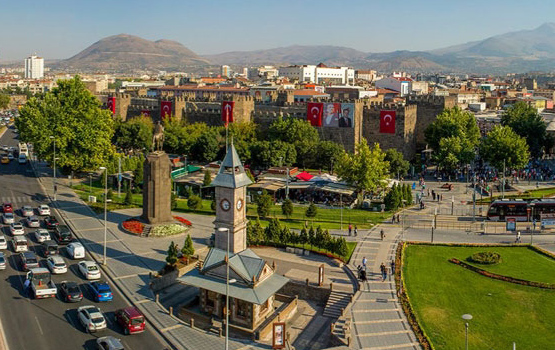Kayseri Hakkında-EN
Kayseri, which is the commercial and industrial center of Central Anatolia, the intersection point of land and railways, has natural beauties as well as rich historical works. Since it is a very old settlement, there are many historical monuments and places. The most important ones belong to the Seljuk and Ottoman periods. Seljuk works are mostly in Kayseri after Konya. Seljuk and Ottoman works of art are worth seeing. Some of the highlights:
Kayseri Castle: It was built by the Byzantine Emperor Justinian in the fifth century. The castle, which was damaged in many battles, was built in the time of Alaeddin Keykubad the First. Later, it was used in Karamanoğlu and Ottomans. Although the inner and outer castle was formed today, the outer castle is very ruined. Inside the castle is 195 square planned bush. There are three doors in the south east and north.
Zamantı Castle: It is near Pinarbasi.
Şahmelik Castle: It is located near Şahmelik village of Develi district. Built during the Roman period, the castle was also used by the Byzantines. Today it is in ruins.
Yeşilhisar Castle: The district is named after.
Develi Castle: It was built on a steep rock to the west of Develi district. It is in ruins.
Hunad Hâtun Complex: It is one of the first complexes built during the Anatolian Seljuk period. It was built in 1238 by Mahperi Hunad Hâtun, the wife of the First Keykubad. The complex consists of mosques, madrasas, tombs and baths. The mosque is minaret. The minaret and the large dome were also built during the reign of Abdulhamid II. The complex is a masterpiece of stonework. The Turkish Bath was commissioned by the General Directorate of Foundations in 1968.
Kölük Mosque and Madrasah: This is the thirteenth century Seljuk work. In 1205, Seljuk Commander Mazaffereddîn Mahmûd´s daughter Atsız Elti Hâtun was built. In 1335, the earthquake was damaged by the earthquake, which is known for his name. The mosque´s mihrab and tiles are very famous. The madrasah has two floors.
Hacı Kılıç Mosque and Madrasa: One of the Seljuk viziers, Abu Kasim Ali, had it built between 1242-1249. The entrance gates of the mosque and madrasah are beautiful examples of exquisite stonework. The mosque looks like a castle from the outside. Made of yellow and black stone.Ulu Mosque: One of the works of Seljuk century. The work made in 1135 is buried in 1.5 m soil. It was built by Melih Mehmed Gâzi. The work, which was seen at various times, lost its original original structure. Next to it are the tomb and the madrasah. Turkey is one of the oldest monuments in Anatolia and the first Turkish mosque, minaret of Turkey´s tallest minaret. At the end of the eighteenth century, Reîsülküttâb Râşit Efendi had a library built next to it. There are many valuable manuscripts.Kurşunlu Mosque: It was built in 1585. It belongs to the Ottoman period. His real name is Hacı Ahmed Pasha Mosque. He is among the works of Mîmar Sinan. Hacı Ahmed Pasha was the captain. The dome is made of lead. In the mosque complex there are caravanserai stages, pasha rooms, madrasah rooms and fountains.
Fatih Sultan Mehmed Mosque: It was built in 1478 by Fatih Sultan Mehmed. It is also known as Kale Câmii because it is inside the castle.
Lalapaşa Mosque: It was built in 1308 by Muslihiddîn Pasha. It is also called Tulip Camii. Pulpit is a unique masterpiece. There is a beard in the cave, which Sultan Abdulhamid II gave as a gift.
Ulu Mosque: It is in Bünyan district. It was built in 1256 by Kaluyan bin Karabuda. The inscriptions and decorations of the crown door are very beautiful. It looks like a castle with cut stone walls.
Develi Ulu Mosque: It is located in Develi district. It was built in 1281 by Göçer Araslan and his wife Saad. The mihrab is very ornamented.
Avgunlu Madrasa: It was built in the thirteenth century. The madrasah was restored by the Regional Directorate of Foundations.
Sâhibiye Madrasa: In 1267, the Seljuk vizier Sâhip Ata had it built. The geometric embroidery surrounding the gate is one of the finest examples of Seljuk stonework.
Pavilion Madrasah: It was built in 1341 by Alaeddin Eratna. It is made of cut stone. There is a tomb in the middle of the courtyard. In the tomb, Alaeddin Eratna and his wife are buried.
Hâtuniye Madrasa: It was built in 1432 by Nâsıreddî Mehmed bin Halil, one of the Dulkadiroğullari. Next to the gate are two beautiful fountains with pointed arches.
Çifte Madrasah (Şifaiye Gıyâsı Madrasah): It consists of two adjoining structures, one of which is a madrasah and one is a hospital. It is the first medical school in the world. In 1205, Seljuk Sultan Gıyâseddîn Keyhüsrev built it as a foundation on his will in the name of his sister Gevher Nesibe Sultan. The gate is one of the interesting examples of Seljuk stonework. Adjacent to the wall of the hospital part is the Tomb of Gevher Nesibe Sultan.
Keykubadiye Palaces: These are the summer buildings built by Alaeddin Keykubad in 1224. It consists of three pavilions on the shore of a small lake.
Sultan Han: It is in the Palas village on the Kayseri-Sivas road. It is understood that the book was made in 1236

